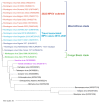Monkeypox: A New Threat?
- PMID: 35887214
- PMCID: PMC9321130
- DOI: 10.3390/ijms23147866
Monkeypox: A New Threat?
Abstract
The global vaccination programme against smallpox led to its successful eradication and averted millions of deaths. Monkeypox virus (MPXV) is a close relative of the Variola (smallpox) virus. Due to antigenic similarity, smallpox vaccines cross-protect against MPXV. However, over 70% of people living today were never vaccinated against smallpox. Symptoms of monkeypox (MPX) include fever, head- and muscle ache, lymphadenopathy and a characteristic rash that develops into papules, vesicles and pustules which eventually scab over and heal. MPX is less often fatal (case fatality rates range from <1% to up to 11%) than smallpox (up to 30%). MPXV is endemic in sub-Saharan Africa, infecting wild animals and causing zoonotic outbreaks. Exotic animal trade and international travel, combined with the increasing susceptibility of the human population due to halted vaccination, facilitated the spread of MPXV to new areas. The ongoing outbreak, with >10,000 cases in >50 countries between May and July 2022, shows that MPXV can significantly spread between people and may thus become a serious threat to public health with global consequences. Here, we summarize the current knowledge about this re-emerging virus, discuss available strategies to limit its spread and pathogenicity and evaluate its risk to the human population.
Keywords: 2022 MPXV outbreak; MPXV; emerging viruses; monkeypox; zoonosis.
Conflict of interest statement
The authors declare no conflict of interest. The funders had no role in the design of the study; in the collection, analyses, or interpretation of data; in the writing of the manuscript; or in the decision to publish the results.
Figures




Similar articles
-
Monkeypox Goes North: Ongoing Worldwide Monkeypox Infections in Humans.Viruses. 2022 Aug 25;14(9):1874. doi: 10.3390/v14091874. Viruses. 2022. PMID: 36146681 Free PMC article. Review.
-
Comprehensive literature review of monkeypox.Emerg Microbes Infect. 2022 Dec;11(1):2600-2631. doi: 10.1080/22221751.2022.2132882. Emerg Microbes Infect. 2022. PMID: 36263798 Free PMC article. Review.
-
The pathophysiological and immunological background of the monkeypox virus infection: An update.J Med Virol. 2023 Jan;95(1):e28206. doi: 10.1002/jmv.28206. Epub 2022 Oct 25. J Med Virol. 2023. PMID: 36217803 Review.
-
Poxvirus Vaccines: Past, Present, and Future.Adv Exp Med Biol. 2024;1451:273-287. doi: 10.1007/978-3-031-57165-7_17. Adv Exp Med Biol. 2024. PMID: 38801584 Review.
-
Monkeypox virus: a re-emergent threat to humans.Virol Sin. 2022 Aug;37(4):477-482. doi: 10.1016/j.virs.2022.07.006. Epub 2022 Jul 9. Virol Sin. 2022. PMID: 35820590 Free PMC article. Review.
Cited by
-
Monkeypox: A comprehensive review of a multifaceted virus.Infect Med (Beijing). 2023 May 12;2(2):74-88. doi: 10.1016/j.imj.2023.04.009. eCollection 2023 Jun. Infect Med (Beijing). 2023. PMID: 38077831 Free PMC article. Review.
-
Estimation of anti-orthopoxvirus immunity in Moscow residents and potential risks of spreading Monkeypox virus.Front Immunol. 2022 Nov 16;13:1023164. doi: 10.3389/fimmu.2022.1023164. eCollection 2022. Front Immunol. 2022. PMID: 36466896 Free PMC article.
-
Monkeypox virus: insights into pathogenesis and laboratory testing methods.3 Biotech. 2024 Mar;14(3):67. doi: 10.1007/s13205-024-03920-z. Epub 2024 Feb 12. 3 Biotech. 2024. PMID: 38357674 Review.
-
Insights into monkeypox pathophysiology, global prevalence, clinical manifestation and treatments.Front Immunol. 2023 Mar 21;14:1132250. doi: 10.3389/fimmu.2023.1132250. eCollection 2023. Front Immunol. 2023. PMID: 37026012 Free PMC article. Review.
-
Monkeypox: a global health emergency.Front Microbiol. 2023 Apr 26;14:1094794. doi: 10.3389/fmicb.2023.1094794. eCollection 2023. Front Microbiol. 2023. PMID: 37180247 Free PMC article. Review.
References
-
- Von Andersen E.K.P.M., Petersen K.B., Birch-Andersen A. A Pox-Like Disease in Cynomolgus Monkeys. Acta Pathol. Microbiol. Scand. 1959;46:156–176.
-
- Multi-Country Monkeypox Outbreak: Situation Update. [(accessed on 1 July 2022)]. Available online: https://www.who.int/emergencies/disease-outbreak-news/item/2022-DON396.
Publication types
MeSH terms
Grants and funding
LinkOut - more resources
Full Text Sources
Medical

